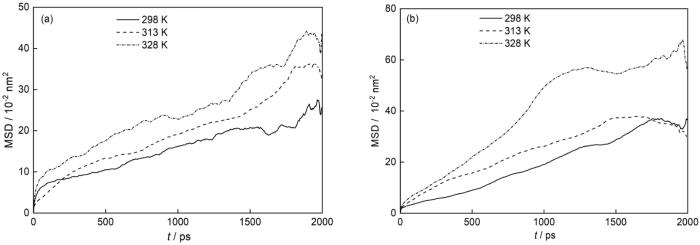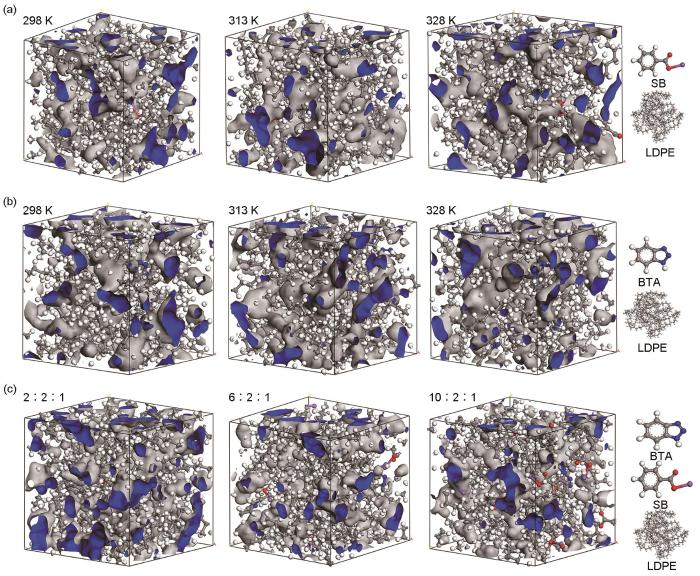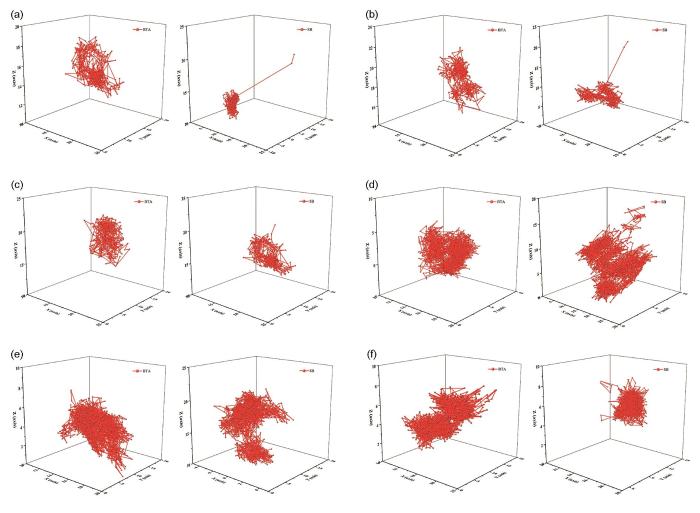气相防锈膜中VCI的扩散行为受温度、VCI结构及种类等多种因素的影响[5],Dudler和Muiños[6]研究了不同取代基的苯骈三氮唑(BTA)在不同形态聚丙烯中的扩散过程,结果表明BTA类稳定剂的结构改变对其扩散速率的影响更显著。作为一项重要的研究手段,分子动力学模拟已成功应用于VCI扩散系数的计算,Basitnezhad和Ebadi-Dehaghani[4]使用热重分析和分子动力学模拟相结合的方法,对含有ECA-5共聚物的聚乙烯VCI膜的防锈效果及缓蚀剂扩散系数的改变进行了研究。Ebadi-Dehaghani[7]利用分子动力学模拟了BTA在不同聚合物中的扩散,结果表明聚合物种类不会对扩散系数产生影响。但已有研究均未从扩散机理角度出发深入分析VCI的扩散行为,欠缺对VCI的释放调控的理论指导。
BTA和苯甲酸钠(SB)是工业上常用的VCI,BTA主要用于Cu及其合金的腐蚀抑制,SB对铁及其合金的防锈保护效果明显,且BTA具有一定的挥发性[5,8]。BTA及SB常被单独或共同添加到低密度聚乙烯(LDPE)薄膜中用于铜和铁的防锈。目前对BTA的扩散研究仍以扩散系数为主,没有对SB在气相防锈膜中的扩散进行研究,更未涉及二者共同在聚合物中的扩散过程。BTA与SB的共同使用会对各自的扩散产生影响,二者分子间的相互作用、BTA及SB与聚合物间的相互作用、扩散体系的自由体积分数等均是影响其扩散的重要因素。明确VCI在聚合物中的扩散行为特性及扩散机理,可以实现对VCI的释放调控,延长防锈时间,提升防锈效果,为新型防锈膜的开发及缓蚀剂配方的调配提供理论参考。
本文采用分子动力学模拟的方法在298、313、328 K温度下分别对BTA、SB单独及不同比例的复配在LDPE中的扩散行为进行研究,并通过计算实验扩散系数的方式验证模拟的准确性。从分子水平分析BTA、SB结构、扩散体系中自由体积、分子间相互作用及LDPE链的流动性对BTA、SB扩散影响,明确BTA、SB在LDPE中的扩散机理。
1 实验与模拟
1.1 实验材料与方法
实验用材料主要包括:BTA(C6H5N3),工业级,国内某防锈公司;SB(C7H5NaO2),工业级;低密度聚乙烯(LDPE),密度0.9225 g/cm3,牌号100 AC;乙醇(C2H5OH),色谱纯。
薄膜制备过程如下:按配比将VCI与LDPE粒子加入高速混合料仓中,并加入适量的硅油增加LDPE粒子与VCI的粘性,充分搅拌混合后使用LTE16-40型双螺杆挤出机制备VCI膜母粒,并用SJ20/25-MF260-3型挤出吹膜机制备VCI膜。含BTA的单组分VCI膜中BTA质量占比为0.5%,含SB的单组分VCI膜中SB质量占比为0.5%;BTA/SB多组分VCI膜中,BTA的质量占比为0.5%,SB的质量占比分别为0.4%、1.2%、2.0%。
迁移实验:将从单组分VCI膜5个不同区域裁剪下的大小为4 cm × 4 cm的样品分别放入298、313和328 K的EDI-302JHHZ-485T型恒温恒湿箱中,在第1、3、10、20、30、40 d分别取出一份样品,使用无水乙醇将VCI膜表面集聚的BTA清洗完全,将清洗液定容后用0.22 μm滤膜过滤,使用QTRAP5500型三重四极杆复合线性离子阱液质(LC-MS/MS)仪测量BTA的含量,结果取每次测定的5片试样结果的平均值。多组分VCI膜的含量测定方法与单组分VCI膜相同。本实验条件下BTA从VCI膜中迁出后集聚在膜表面,BTA的挥发性低,挥发量极少,BTA的挥发量与膜表面的集聚量相比可忽略不计,此迁移实验对BTA迁出量的测量有效,测定结果准确。
BTA标准曲线:制备BTA中间液(1 mg/L)并稀释得到BTA工作液(0.1、1、2、10、50 μg/L),使用LC-MS/MS仪器进行测试分析,绘制苯骈三氮唑标准曲线。
1.2 分子动力学模拟
基于Materials Studio软件模拟BTA和SB在LDPE中的扩散行为,模拟过程如图1所示。
图1
1.2.1 扩散晶胞模型的构建
通过Materials Studio软件Visualizer模块构建BTA分子、SB分子及LDPE分子链,其中LDPE链的聚合度为160,并对其进行几何优化。在Amorphous Cell模块中构建BTA-LDPE、SB-LDPE和BTA-SB-LDPE扩散晶胞模型,BTA-LDPE、SB-LDPE晶胞的温度条件设置为298、313、328 K,每个扩散晶胞中分别包含1条LDPE分子链和2个扩散分子。BTA-SB-LDPE晶胞的温度条件设置为313 K,3种晶胞中均含1条LDPE分子链和2个BTA分子,SB分子数分别为2、6、10,对构建好的晶胞采用smart算法进行能量优化,力场选择COMPASS Ⅱ,截断半径为1.25 nm。扩散晶胞模型参数见表1,结构如图2所示。
表1 扩散晶胞模型参数
Table 1
| Model | Temperature / K | SB | BTA | LDPE |
|---|---|---|---|---|
| BTA-LDPE | 298 | 0 | 2 | 1 |
| 313 | ||||
| SB-LDPE | 2 | 0 | 1 | |
| 328 | ||||
| BTA-SB-LDPE | 313 | 2 | 2 | 1 |
| 6 | 2 | 1 | ||
| 10 | 2 | 1 |
图2
图2
313 K下不同扩散体系的晶胞结构
Fig.2
Cell structure of different diffusion systems at 313 K: (a) SB-LDPE, (b) BTA-LDPE, (c) SB-BTA-LDPE
1.2.2 分子动力学模拟过程
在“Forcite”模块中的Anneal部分对扩散晶胞进行退火处理,将系统温度从300 K加热至600 K,再冷却至300 K,温度改变间隔为50 K,每个温度下均进行40 ps的NPT模拟,循环5次。退火后进行动力学驰豫,在Dynamics任务下选择NPT系综进行200 ps的动力学模拟,完成后进行NVT系综动力学模拟,时间为2 ns,由于多组分VCI扩散晶胞体量较大,为保证模拟结果的准确性,将模拟时长增加至10 ns。时间步长为1 fs,采样频率为1帧/5000步。通过分析模拟过程中的温度和能量曲线判定体系是否达到动力学平衡状态,当其波动范围不超过5%则标志体系达到平衡,可进行后续的分析计算[9]。
2 结果与讨论
2.1 扩散系数
2.1.1 模拟扩散系数
扩散分子的运动速率用扩散系数表示,通过均方位移曲线(MSD)计算,其中Einsten法最为常用[10],如下式所示:
式中:N是扩散粒子数目;t是扩散时间,s;ri (t)是扩散粒子在t时刻的位移,0.1 nm;<|ri(t)- ri(0)|2 >是系综平均值;MSD是均方根位移,0.01 nm2;D是扩散系数,cm2/s。
取MSD曲线中的线性部分,
式中:a是MSD曲线中线性部分的斜率。
图3
图3
不同温度下BTA/SB在LDPE中扩散的MSD
Fig.3
MSD of BTA/SB in LDPE at different temperatures: (a) BTA-LDPE, (b) SB-LDPE
图4
图4
313 K下BTA/SB不同配比的MSD
Fig.4
MSD with different ratios of BTA/SB at 313 K: (a) SB-BTA-LDPE = 2∶2∶1, (b) SB-BTA-LDPE = 6∶2∶1, (c) SB-BTA-LDPE = 10∶2∶1
表2 不同扩散体系中BTA和SB分子的扩散系数
Table 2
| Model | Temperature / K | Diffusion coefficient / cm2·s-1 | |
|---|---|---|---|
| BTA | SB | ||
| BTA-LDPE | 298 | 1.96 × 10-7 | - |
| 313 | 2.22 × 10-7 | - | |
| 328 | 2.43 × 10-7 | - | |
| SB-LDPE | 298 | - | 3.16 × 10-7 |
| 313 | - | 3.94 × 10-7 | |
| 328 | - | 6.51 × 10-7 | |
| SB-BTA-LDPE = 2∶2∶1 | 313 | 9.03 × 10-8 | 1.62 × 10-7 |
| SB-BTA-LDPE = 6∶2∶1 | 4.75 × 10-8 | 7.07 × 10-8 | |
| SB-BTA-LDPE = 10∶2∶1 | 2.57 × 10-8 | 3.38 × 10-8 | |
结果可知在298、313、328 K条件下,单组分扩散时BTA、SB的扩散系数随温度的升高而增大,且BTA的扩散系数要小于SB;而多组分扩散时,BTA、SB的扩散系数较单组分扩散小,且BTA、SB的扩散系数随SB占比的增大而减小,说明扩散体系中SB的加入会导致BTA、SB扩散速率的减慢,SB含量越大,BTA、SB的扩散速率越慢,可以推测BTA与SB的共同扩散会对BTA的扩散速率产生抑制作用,且SB的占比越大,抑制作用越强。
2.1.2 BTA实验扩散系数
扩散系数是通过VCI的迁移量计算,实验中以BTA扩散系数为例进行计算以验证MD模拟方法的有效性。BTA含量的标准曲线方程:y = 7.2085 × 105x + 3.1697 × 105,R² = 0.994。不同VCI膜中BTA的迁移量如图5所示。BTA的迁移量随着温度的升高而增多,而当SB缓蚀剂加入后,BTA的扩散受到限制,扩散量减小,且随着SB添加量的增大,扩散量的减少越多。通过
图5
图5
不同扩散体系中BTA的释放量
Fig.5
Release amount of BTA in different diffusion systems: (a) release of BTA one-component VCI film at different temperatures, (b) release of BTA from two-component VCI film at 313 K
表3 BTA扩散系数实验值
Table 3
| Model | Temperature / K | Diffusion coefficient / cm2·s-1 |
|---|---|---|
| BTA-LDPE | 298 | 1.37 × 10-8 |
| 313 | 2.89 × 10-8 | |
| 328 | 4.02 × 10-8 | |
| SB-BTA-LDPE = 2∶2∶1 | 313 | 9.12 × 10-9 |
| SB-BTA-LDPE = 6∶2∶1 | 8.36 × 10-9 | |
| SB-BTA-LDPE = 10∶2∶1 | 7.49 × 10-9 |
式中:t是扩散时间,s;MF,t 是t时刻VCI从VCI膜中迁出的量,μg;MF,∞ 是扩散平衡时VCI的迁出量,μg;Lp是VCI膜的厚度,cm;DP是扩散系数,cm2/s。
2.2 扩散机理
2.2.1 分子形状与大小
图6
BTA和SB的回转半径分别为1.91、2.56,对应VCI的分子量,与扩散系数大小规律一致。一般而言,扩散分子的分子量和回旋半径越大,其扩散所需的空间和通道越大,扩散系数越小,而SB、BTA的扩散规律却相反,表明VCI分子的大小对其扩散影响不明显。SB与BTA的结构表明二者均含有苯环结构,但SB的分子结构更加松弛,流动性更强,BTA属于含氮杂环化合物,结构刚性大,流动性较差,更不容易扩散,VCI的结构可能会对其扩散产生影响。
2.2.2 自由体积
图7
图7
不同扩散体系的自由体积分布
Fig.7
Free volume distribution of different diffusion systems: (a) free volume distribution of SB-LDPE system at 298, 313 and 328 K, (b) free volume distribution of BTA-LDPE system at 298, 313 and 328 K, (c) free volume distribution of different formulations of BTA-SB-LDPE system at 313 K
表4 不同扩散体系的自由体积分数
Table 4
| Model | Temperature / K | FFV / % |
|---|---|---|
| BTA-LDPE | 298 | 15.31 |
| 313 | 19.07 | |
| 328 | 19.56 | |
| SB-LDPE | 298 | 16.47 |
| 313 | 19.35 | |
| 328 | 19.98 | |
| SB-BTA-LDPE = 2∶2∶1 | 313 | 19.07 |
| SB-BTA-LDPE = 6∶2∶1 | 16.64 | |
| SB-BTA-LDPE = 10∶2∶1 | 12.54 |
2.2.3 相互作用能
表5 扩散体系中VCI分子与扩散体系的相互作用能
Table 5
| Model | Temperature / K | Interaction energy / J·mol-1 | |
|---|---|---|---|
| BTA | SB | ||
| BTA-LDPE | 298 | -166,602.80 | - |
| 313 | -153,793.64 | - | |
| 328 | -153,668.06 | - | |
| SB-LDPE | 298 | - | -150,109.96 |
| 313 | - | -144,082.12 | |
| 328 | - | -136,589.18 | |
| SB-BTA-LDPE = 2∶2∶1 | 313 | -352,963.52 | -354,010.02 |
| SB-BTA-LDPE = 6∶2∶1 | -429,148.72 | -744,480.10 | |
| SB-BTA-LDPE = 10∶2∶1 | -520,570.96 | -1,107,364.44 | |
单组分扩散体系中,SB与LDPE的相互作用小于BTA,故对SB扩散速率的影响较小;SB-LDPE、BTA-LDPE扩散体系中的VCI分子与LDPE的相互作用随着温度的升高而减小。多组分扩散时,两种VCI分子与体系间相互作用较单组分扩散时大,表明两种VCI分子间存在相互作用,且随着SB占比的增大而增强,这与扩散系数的大小规律相吻合。VCI分子与体系间的相互作用能是影响扩散速率的重要原因。
2.2.4 LDPE链的流动性
图8
图8
不同扩散体系中LDPE自扩散的MSD
Fig.8
MSD of LDPE self-diffusion in different diffusion systems: (a) BTA-LDPE, (b) SB-LDPE, (c) BTA-SB-LDPE
表6 不同扩散体系中LDPE的自扩散系数
Table 6
| Model | Temperature / K | Self-diffusion coefficient / cm2·s-1 |
|---|---|---|
| BTA-LDPE | 298 | 6.24 × 10-8 |
| 313 | 9.37 × 10-8 | |
| 328 | 1.08 × 10-7 | |
| SB- LDPE | 298 | 1.13 × 10-7 |
| 313 | 1.34 × 10-7 | |
| 328 | 1.39 × 10-7 | |
| SB-BTA-PE = 2∶2∶1 | 313 | 6.70 × 10-8 |
| SB-BTA-PE = 6∶2∶1 | 5.22 × 10-8 | |
| SB-BTA-PE = 10∶2∶1 | 3.81 × 10-8 |
BTA-LDPE、SB-LDPE体系中LDPE的自扩散系数随温度的升高而增大;在多组分扩散体系中随着SB含量的增加而减小。BTA、SB的扩散速率与LDPE的自扩散速率变化趋势一致,温度升高使LDPE链更松弛柔软,流动性增强,参与分子运动的链段增多,从而带动了VCI的运动[17];SB含量的增加减小了体系中自由体积,增强了VCI分子间相互作用,降低了LDPE链的流动性,从而减缓了BTA扩散。
2.2.5 VCI分子扩散轨迹
图9
图9
不同扩散体系中BTA/SB分子的扩散轨迹
Fig.9
Diffusion trajectories of BTA, SB in different diffusion systems: (a) diffusion trajectories of BTA, SB in LDPE at 298 K, (b) diffusion trajectories of BTA, SB in LDPE at 313 K, (c) diffusion trajectories of BTA, SB in LDPE at 328 K, (d) diffusion trajectories of BTA, SB in SB-BTA- LDPE (2∶2∶1) at 313 K, (e) diffusion trajectories of BTA, SB in SB-BTA- LDPE (6∶2∶1) at 313 K, (f) diffusion trajectories of BTA, SB in SB-BTA-LDPE (10∶2∶1) at 313 K
VCI分子的扩散轨迹中重叠部分较离散部分更多,说明VCI分子长时间内在某一空穴中来回振动,以蠕动扩散方式为主。BTA、SB分子的扩散轨迹中有明显的团簇,说明VCI分子随着LDPE分子链的运动产生了足以容纳VCI分子的空穴,因此发生了运动[8]。SB的扩散轨迹更为离散,运动更活跃,扩散速率更快;团簇及重叠的范围随着温度的升高而变大,说明分子运动更加剧烈,扩散速率更快。在多组分扩散中随着SB含量的增大,BTA的扩散轨迹范围减小,说明BTA的运动受到了更多限制,扩散速率减慢。
3 结 论
本研究通过分子动力学模拟的方法对不同温度下两种缓蚀剂(BTA、SB)在LDPE膜中的扩散行为进行了研究。BTA、SB在LDPE中以蠕动扩散为主。BTA、SB的扩散速率随着温度的升高而增大,单组分扩散时BTA的扩散速率较SB小,多组分扩散时SB、BTA的扩散速率减小,且SB含量的增加会减缓BTA的扩散。实验验证了缓蚀剂扩散系数的实验值与模拟值变化趋势相同,在数值上相差一个数量级。VCI分子结构、体系自由体积、LDPE的自扩散及VCI分子与扩散体系的相互作用共同影响VCI的扩散速率,其中VCI分子间的相互作用是导致多组分扩散中BTA扩散速率减小的重要原因,SB的添加会对VCI的扩散产生抑制作用。VCI在LDPE中扩散机制可为VCI膜中VCI释放速率的控制及防锈效果的提升提供依据,也为新型VCI膜的开发提供重要的参考。
参考文献
Reviews on corrosion inhibitors: a short view
[J].
Key issues regarding development of volatile corrosion inhibitors and their application
[J].
气相缓蚀剂的研究开发及应用中若干问题的探讨
[J].
Technological applications of volatile corrosion inhibitors
[J].
Controlled release of novel volatile corrosion inhibitor (VCI) nanoparticles incorporated in low density polyethylene (LDPE) films for steel coverings: correlation of experimental results with molecular dynamics simulation
[J].
Recent developments in the volatile corrosion inhibitor (VCI) coatings for metal: a review
[J].
Diffusion of benzotriazoles in polypropylene: influence of polymer morphology and stabilizer structure
[J].
Diffusion of 1,2,3-benzotriazole as a volatile corrosion inhibitor through common polymer films using the molecular dynamics simulation method
[J].
Research progress of volatile corrosion inhibitor
[J].
气相缓蚀剂及其研究进展
[J].
Study of the glass transition temperature and the mechanical properties of PET/modified silica nanocomposite by molecular dynamics simulation
[J].
Molecular dynamics simulation of corrosive particle diffusion in benzimidazole inhibitor films
[J].
Controlled release mechanism of complex bio-polymeric emulsifiers made microspheres embedded in sodium alginate based films
[J].
Effect of migrant size on diffusion in dry and hydrated polyamide 6
[J].
Molecular dynamics simulation of the influence of PEG-TDI aging degradation on diffusibility and compatibility of NG and BTTN
[J].
Free volume in polyimides: positron annihilation experiments and molecular modeling
[J].
Structure and thermodynamic properties from molecular dynamics simulations of the polyethylene crystal
[J].
Development of active low-density polyethylene (LDPE) antioxidant packaging films: controlled release effect of modified mesoporous silicas
[J].
Self-assembly behavior of temperature sensitive additive in polypropylene matrix: molecular dynamics simulations
[J].
New effective method for quantitative analysis of diffusion jumps, applied in molecular dynamics simulations of small molecules dispersed in short chain systems
[J].













